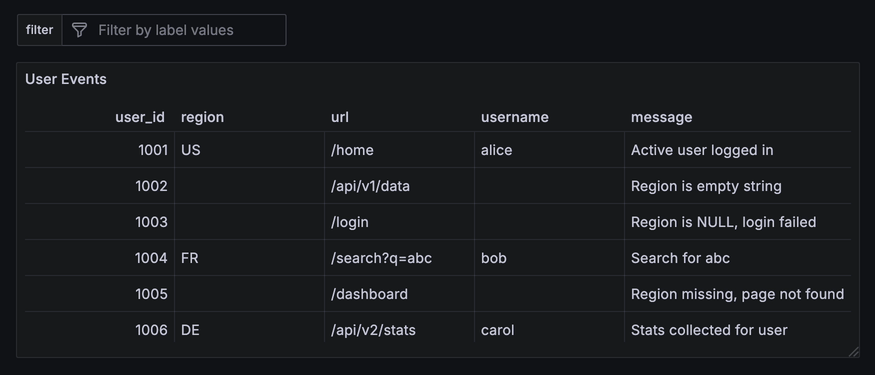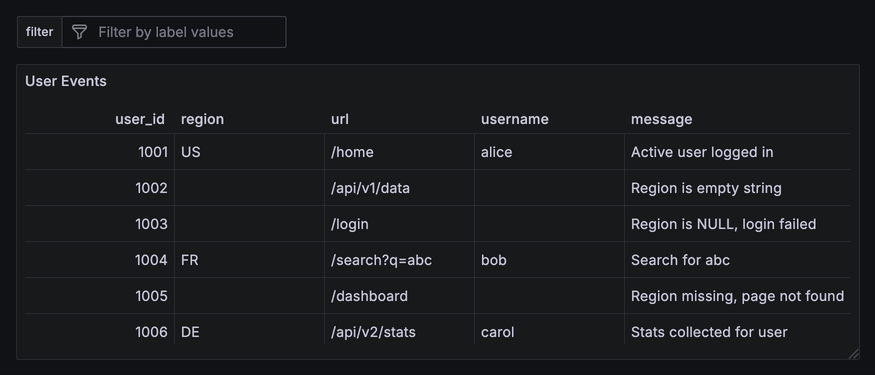Hydrolix Data Source Plugin for Grafana
Use the Hydrolix plugin for Grafana
Overview
The Hydrolix data source plugin for Grafana is a secure and high-performance way to query data from a Hydrolix cluster in Grafana. It includes:
- Autocompletion for data stores, tables, columns, and SQL syntax
- Support for template variables and macros
- Automatic SQL formatting
The plugin also improves query efficiency, reducing cluster load and query costs.
This page describes extra configuration options and plugin features you can use after you install and configure the plugin in Grafana.
Before you begin
If you haven't deployed Grafana, see the Grafana automatic installation to deploy it in a Hydrolix cluster.
To deploy Grafana outside the Hydrolix cluster, see Grafana manual installation.
You must have an organization administrator role to add or remove data sources.
Configure the data source
Configure the Hydrolix data source in Grafana, or with configuration files.
| Option name | Description | Example value |
|---|---|---|
| Name | The name used to reference this data source in panels and queries | hydrolix |
| Default | Set to make this Hydrolix data source the default in panels and visualizations |
Server settings
| Option name | Description | Example value |
|---|---|---|
| Server address | The IP address or hostname of your Hydrolix instance | {myhost}.hydrolix.live |
| Server port | The port on which your Hydrolix instance is running | 9444 |
| Use default | Set to use the default port instead of specifying a custom one. | |
| Protocol | The communication protocol used: Native or HTTP | HTTP |
| Secure connection | Set to enable a secure connection. | |
| HTTP URL path (optional) | Additional URL path for HTTP requests | /query |
TLS settings
| Option name | Description | Example value |
|---|---|---|
| Skip TLS verify | Toggle to bypass TLS certificate verification. Not recommended unless absolutely necessary for testing. |
Credentials settings
| Option name | Description | Example value |
|---|---|---|
| Credentials Type | Credentials type for connecting to your Hydrolix instance: user account or service account. | Service Account |
| Token | A service account token. You can generate a token using the UI instructions or the API instructions. | eyJhbGciOiJFZERTQSIsIn... |
| Username | A user account username. | username |
| Password | A user account password. | password |
Additional settings (optional)
| Option name | Description | Example value |
|---|---|---|
| Default database | Use when no database is specified in the query. | my_project |
| Default round | Use when a query doesn't specify a round value. Round $from and $to to the nearest multiple of this value. See round timestamps. | 60s |
| Ad hoc filter table variable name | Defines which table to use for retrieving ad hoc filter columns and values. | table |
| Ad hoc filter values query condition variable name | Name of the dashboard variable that defines a query condition used to filter ad hoc filter values | |
| Ad hoc filter default time range | Default time range when the dashboard does not have one | |
| Dial timeout | Connection timeout in seconds | 120 |
| Query timeout | Read timeout for a query in seconds | 60 |
Set query options
Send Hydrolix query options with every query from the data source. They're wrapped as CustomSetting values.
Only a subset of query options are supported.
To add a query option:
- Select a setting from the dropdown list.
- Enter a value.
Use Grafana variables or dashboard template variables.
If a variable isn’t defined, it stays as-is.
Synthetic variables supported:
${__hydrolix.raw_query}- Raw query text before interpolation.${__hydrolix.query_source}- Query source from theDataQueryRequest.appfield. For example, use this variable to determine if the query came from Explore or another source.
Provision the data source
To provision the Hydrolix data source using Grafana’s provisioning system, define it in a YAML configuration file.
The following examples show how to provision the data source.
Use HTTPS protocol
apiVersion: 1
datasources:
- name: "Hydrolix"
type: "hydrolix-hydrolix-datasource"
jsonData:
host: localhost
port: 443
protocol: http
secure: true
username: username
path: /query
secureJsonData:
password: password
Use native protocol
apiVersion: 1
datasources:
- name: "Hydrolix"
type: "hydrolix-hydrolix-datasource"
jsonData:
host: localhost
port: 9440
protocol: native
secure: true
username: username
secureJsonData:
password: password
Use HTTPS protocol with defaults and ad hoc filters
apiVersion: 1
datasources:
- name: "Hydrolix"
type: "hydrolix-hydrolix-datasource"
jsonData:
host: localhost
port: 443
protocol: http
secure: true
username: username
path: /query
defaultDatabase: database
defaultRound: 60s
adHocTableVariable: table
secureJsonData:
password: password
For more details about provisioning, see Grafana’s Provisioning documentation.
Query the data source
The query editor in Grafana supports SQL with syntax enhancements such as macros and templates.
SQL query editor
The editor provides extensive SQL capabilities:
- Autocompletion for databases, tables, columns, and SQL syntax.
- Template variable and macro support.
- Code formatting.
Keyboard shortcuts
- Cmd / Ctrl + Return: Run the query
Macros
Use macros to simplify syntax and add dynamic elements such as date range filters.
| Macro | Description | Output example |
|---|---|---|
$__dateFilter(column) | Generates a condition to filter data, using the provided column, based on the panel's date range | date >= toDate('2022-10-21') AND date <= toDate('2022-10-23') |
$__timeFilter([column]) | Generates a condition to filter data based on the panel's time range in seconds. Accepts an optional column name. If no column is provided, the primary key is used automatically. | time >= toDateTime(1415792726) AND time <= toDateTime(1447328726) |
$__timeFilter_ms([column]) | Generates a condition to filter data based on the panel's time range in milliseconds. Accepts an optional column name. If no column is provided, the primary key is used automatically. | time >= fromUnixTimestamp64Milli(1415792726123) AND time <= fromUnixTimestamp64Milli(1447328726456) |
$__dateTimeFilter(dateColumn, timeColumn) | Combines $__dateFilter() and $__timeFilter() for filtering with separate date and time columns | $__dateFilter(dateColumn) AND $__timeFilter(timeColumn) |
$__adHocFilter | Replaced with a condition to filter data based on the applied ad hoc filters | statusCode = '200' |
$__fromTime | Replaced with the panel's start time, cast as DateTime | toDateTime(1415792726) |
$__toTime | Replaced with the panel's end time, cast as DateTime | toDateTime(1447328726) |
$__fromTime_ms | Replaced with the panel's start time, cast as DateTime64(3) (millisecond precision) | fromUnixTimestamp64Milli(1415792726123) |
$__toTime_ms | Replaced with the panel's end time, cast as DateTime64(3) (millisecond precision) | fromUnixTimestamp64Milli(1447328726456) |
$__interval_s | Replaced with the interval in seconds | 20 |
$__timeInterval([column]) | Calculates intervals based on panel width, useful for grouping data in seconds. Accepts an optional column name. If no column is provided, the primary key is used automatically. | toStartOfInterval(toDateTime(column), INTERVAL 20 second) |
$__timeInterval_ms([column]) | Calculates intervals based on panel width, useful for grouping data in milliseconds. Accepts an optional column name. If no column is provided, the primary key is used automatically. | toStartOfInterval(toDateTime64(column, 3), INTERVAL 20 millisecond) |
$__conditionalAll(condition, $templateVar) | Includes the provided condition only if the template variable doesn't select all values, defaults to 1=1 otherwise | condition or 1=1 |
This example shows a query with the $__timeFilter macro:
SELECT $__timeInterval(log_time) AS time, avg(cpu_usage) AS value
FROM logs
WHERE $__timeFilter()
GROUP BY time
ORDER BY time
Ad hoc filters
Use ad hoc filters to dynamically filter column values.
Grafana injects these filters into queries with the $__adHocFilter macro. You must include the macro in the WHERE clause:
SELECT $__timeInterval(log_time) AS time, avg(cpu_usage) AS value
FROM logs
WHERE $__timeFilter() AND $__adHocFilter()
GROUP BY time
ORDER BY time
The plugin ensures filters are applied only when valid for the selected table.
Configure ad hoc filters
To enable ad hoc filters, configure both the data source and the dashboard:
-
In Data source settings > Additional Settings, add values for the following:
- Ad hoc filter table variable name: the name of a dashboard variable that defines the table used to retrieve column names and their values for ad hoc filters.
- Ad hoc filter default time range: a default time range to use when the dashboard time range is unavailable.
-
In the target dashboard, create variables using the exact names defined in the data source settings.
Make sure the configuration and dashboard variable match
Ad hoc filters won't work unless both the data source and the dashboard are configured correctly. Be sure to match variable names exactly.
Limit ad hoc filter values
This plugin allows limiting ad hoc filter values based on a specified condition.
For example, if a dashboard only shows data from hosts with commercial domains, you can restrict the filter values using a condition like: host like '%.com'.
To apply the limit ad hoc filters, both the data source and the dashboard need additional configuration:
-
In Data source settings > Additional Settings, add values for the following:
- Ad hoc filter values query condition variable name: the name of a dashboard variable that defines query condition to filter ad hoc filter values.
-
In the target dashboard, create a Constant (Const) variable with the name you set in Ad hoc filter values query condition variable name. For example, set its value to `host like %.com'.
Empty and null values
Ad hoc filters support two synthetic values to help identify and query rows with missing or blank data:
__null__: matches rows where the column value isNULL.__empty__: matches rows where the column value is an empty string.
These synthetic values appear in the ad hoc filter suggestions only if the underlying data contains NULL or empty strings for the selected column and dashboard time range.
If the data contains literal values such as __null__ or __empty__, those will also be matched by the corresponding filters.

Wildcards
Ad hoc filters support wildcard filtering using the =~ and !~ operators. These operators allow matching or excluding values based on simple patterns that include the * wildcard character. Full regular expressions aren't supported.
The * symbol matches any sequence of characters, including an empty one. For example, *user* will match any value that contains the substring user, regardless of what comes before or after.
To match a literal asterisk (*), escape it with a backslash (\*). For example, to search for the exact string
*debug*, enter: \*debug\*.
To apply a wildcard filter:
- On the dashboard, click inside the filter field.
- Select the column you want to filter such as
message. - Choose the operator
=~or!~. - Type your full wildcard pattern. For example:
*user*. - Don't select any of the suggested values while typing.
- As you type, an option appears at the bottom of the suggestion list:
Use custom value: *user*. - Click this option to apply the filter.

Round timestamps
To control how time ranges are aligned, $from and $to timestamps can be rounded to the nearest multiple of the round value. This is set in the query editor or in the data source settings.
When a round value is set in the query editor, it takes precedence and is always used. If no round is set in the query editor, the data source falls back to the default round if it's configured and non-zero. If neither is set, or if the round value in the query editor is explicitly set to 0, no rounding occurs.
The supported time units for rounding are: ms (milliseconds), s (seconds), m (minutes), and h (hours).
Examples
| Default round | Query round | Effective round | Input timestamp | Rounded timestamp |
|---|---|---|---|---|
5m | not set | 5m | 10:07:20 | 10:05:00 |
5m | 1m | 1m | 09:02:30 | 09:03:00 |
| not set | not set | not applied | 08:01:23 | 08:01:23 |
5m | 0 | not applied | 07:45:50 | 07:45:50 |
Template variables
Hydrolix queries fully support Grafana's template variables to create dynamic and reusable dashboards.
For more details about template variables, see Grafana’s add variables documentation.
Updated about 2 months ago